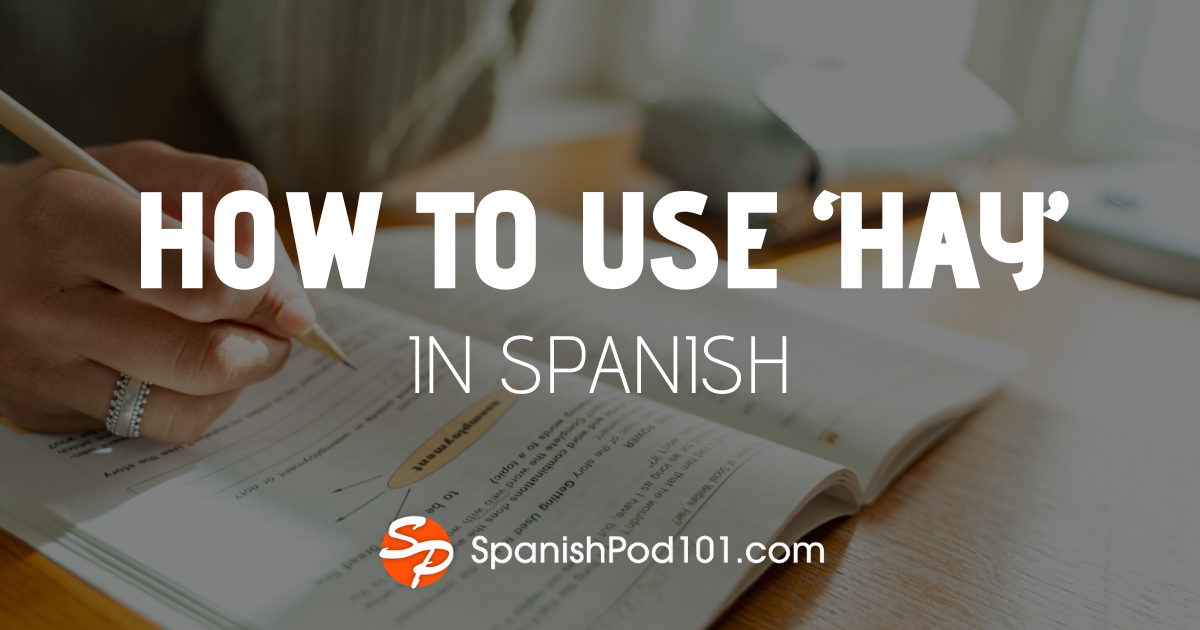Can you spot adverbs in a novel? If your answer is no, don’t be embarrassed. We sometimes forget what adverbs do in a sentence—you may not even remember what “adverb” actually means.
When learning a second language, it’s normal to forget this type of information.
Spanish adverbs aren’t that different from those in English, but there are a few tricks about how to identify them and where to put them in a sentence. In this article, we’ll teach you all about Spanish adverbs, and we’ll also provide an excellent list of 100 Spanish adverbs and their meanings.
 Table of Contents
Table of Contents
- What are Spanish Adverbs?
- How Do You Form an Adverb in Spanish?
- The 100 Most Useful Spanish Adverbs
- Conclusion
1. What are Spanish Adverbs?

Spanish adverbs are a very important part of your Spanish learning. They help you make a point clear, explain when something happened, and show how something was done, which are crucial elements when communicating in any language.
Unlike Spanish nouns, Spanish adverbs have no gender, number, or person. But, occasionally, you can add a diminutive with a suffix.
- Pronto >> Prontito >> “Very soon”
- Poco >> Poquito >> “A little bit”
- Cerca >> Cerquita >> “Very close”
- Despacio >> Despacito >> “Very slowly”
You can also add augmentative suffixes, such as:
- Lejos >> Lejísimos >> “Extremely far”
- Despacio >> Despacísimo >> “Extremely slowly”
The main characteristic of Spanish adverbs is that they complement the point you’re trying to make. They represent the circumstances of time, place, and mode in which an action occurs. Let’s see how.
2. How Do You Form an Adverb in Spanish?
Spanish adverbs modify or go with:
- Verbs: Corre rápidamente. (“Run quickly.”)
- Adjectives: Más lento. (“Slower.”) You can spot these easily because they go before the adjective.
- Other adverbs: Bastante lejos. (“Pretty far.”)
You can get a Spanish adverb from an adjective by adding the ending -mente. Here are a few examples of Spanish adverbs ending in -mente, and how they’re formed:
- General (“General”) >> Generalmente (“Generally”)
- Ocasional (“Occasional”) >> Ocasionalmente (“Occasionally”)
- Frecuente (“Frequent”) >> Frecuentemente (“Frequently”)
- Suave (“Soft”) >> Suavemente (“Softly”)
- Rápido (“Quick”) >> Rápidamente (“Quickly”)
This is very common, and it’s very easy to understand Spanish adverbs. There’s a general rule attached to this kind of adverb, and you can see that the same rule applies to the English language, where you just add the suffix “-ly” to the adjectives.
One more thing you need to keep in mind is that if you want to use two adverbs with the suffix -mente in the same sentence, the first one will be used as an adjective and the second one will have the -mente suffix.
For example:
- Hice el Camino de Santiago lenta y tranquilamente.
“I did the Camino de Santiago slowly and calmly.”
- Me dijo que me callara dulce y suavemente.
“She told me to shut up sweetly and softly.”
3. The 100 Most Useful Spanish Adverbs

In the following sections, you can find all of the most common Spanish adverbs for describing time, place, manner, degree, and more!
- →Keep in mind that for additional Spanish adverbs, SpanishPod101.com has a brief vocabulary list you can check out!
1- Spanish Adverbs of Time

Spanish adverbs of time will help you provide information about when, how often, or for how long something happens. Here’s a short Spanish adverbs list, with examples of how each one is used.
- Antes (“Before”)
Antes de comer aceitunas prefiero patatas fritas.
“Before eating olives, I’d prefer chips.”
- Después (“After”)
Después de las cinco no suelo comer nada.
“After five p.m., I don’t usually eat.”
- Hoy (“Today”)
Hoy es el día de la madre.
“Today is Mother’s Day.”
- Mañana (“Tomorrow”)
Mañana tengo clase de ballet.
“I have ballet class tomorrow.”
- Anoche (“Last night”)
Anoche soñé con mi padre.
“I dreamed about my father last night.”
- Anteanoche (“The night before yesterday”)
Antenoche no pude dormir.
“I could not sleep the night before yesterday.”
- Ayer (“Yesterday”)
Ayer fue el cumpleaños de mi hermano.
“It was my brother’s birthday yesterday.”
- Anteayer (“The day before yesterday”)
Anteayer comí pasta.
“I had pasta the day before yesterday.”
- Ya (“Already”)
Ya llegaron los pedidos pendientes.
“The pending orders have already arrived.”
- Siempre (“Always”)
Siempre suelo quedarme dormida viendo la tele.
“I always fall asleep watching TV.”
- Todavía (“Yet”)
Todavía no me han llegado los pedidos.
“My orders haven’t arrived yet.”
- Ahora (“Now”)
Ahora voy al gimnasio.
“I am going to the gym now.”
- Tarde (“Late”)
Maite siempre llega media hora tarde cuando quedamos.
“Maite always arrives half an hour late when we meet.”
- Luego (“Later”)
¿Nos vemos luego?
“Will I see you later?”
- Mientras (“While”)
Corrió hacia su coche mientras llovía.
“He ran toward his car while it was raining.”
- Recién (“Freshly”)
¡No pases! El suelo está recién fregado.
“Do not pass over here! The floor is freshly scrubbed.”
Although in English, adverbs of frequency and adverbs of time are considered separate categories, in Spanish, they fall under the same category.
The following Spanish adverbs of frequency will help you describe how frequently you do something. Whether you go to the gym very often (Voy a gimnasio a menudo) or everyday (Voy al gimnasio todos los días), you can tell people about it using these adverbs.
Once you’re through with this list, tell us how often you usually check up on our blog!

- Semanalmente (“Weekly”)
Suelo ir a la piscina semanalmente.
“I usually go to the pool weekly.”
- Siempre (“Always”)
Siempre voy al gimnasio los lunes.
“I always go to the gym on Mondays.”
- Mucho (“A lot”)
Yo voy mucho al gimnasio.
“I go to the gym a lot.”
- Actualmente (“Currently”)
Actualmente vivo del alquiler de mi casa.
“Currently, I live renting my house.”
- Frecuentemente (“Frequently”)
Mi perro se pierde frecuentemente.
“My dog gets lost frequently.”
- Recientemente (“Recently”)
He perdido a mi perro recientemente.
“I have lost my dog recently.”
- Diariamente (“Daily”)
Suelo meditar diariamente.
“I meditate daily.”
- Nunca (“Never”)
Nunca me llegan las cosas a tiempo.
“I never get my things on time.”
- Raramente (“Rarely”)
Raramente me cuestiono sobre la vida.
“I rarely ask myself about life.”
- Usualmente (“Usually”)
Usualmente no bebo alcohol.
“I do not usually drink alcohol.”
- Normalmente (“Normally”)
Normalmente mi padre tiene pan en casa.
“Normally, my dad has bread at home.”
- Todo el tiempo (“All the time”)
Mi pareja suele quejarse todo el tiempo cuando ve la tele.
“My partner complains all the time while he watches TV.”
- De vez en cuando (“From time to time”)
Suelo ir a jugar baloncesto de vez en cuando con mis amigas.
“I play basketball from time to time with my girlfriends.”
- Anualmente (“Annually”)
Mi gato tiene sus vacunas anualmente.
“My cat has his vaccines annually.”
- A veces (“Sometimes”)
A veces salgo a patinar por el paseo marítimo.
“Sometimes I go roller skating along the seaside.”
- Poco (“A little”)
Salgo muy poco de fiesta.
“I go out very little.”
- Apenas (“Hardly”)
Apenas puedo ir al teatro.
“I hardly ever go to the theater.”
- Jamás (“Never”)
Jamás llego tarde a mis clases de ballet.
“I am never late to my ballet lessons.”
2- Spanish Adverbs of Place

Where is your phone? Is it here? Did you lose your glasses? Are they close or far away? These useful Spanish adverbs will help you answer questions about where things are. You should learn them because they’re very common and are used in everyday Spanish.
- Aquí (“Here”)
Aquí en España hay muchos extranjeros.
“Here in Spain, there are many foreigners.”
- Allí (“There”)
Allí donde está Luis estudiando hay cursos para ti también.
“There, where Luis is studying, there are courses for you as well.”
- Cerca (“Near”)
La biblioteca está cerca de mi casa.
“The library is near my place.”
- Delante (“In front of”)
Hay un banco delante del gimnasio.
“There is a bank in front of my gym.”
- Acá (“Here”)
Vamos a comer acá en mi casa.
“We are going to eat here at home.”
- Allá (“There,” “Over there”)
El supermercado está allá.
“The supermarket is over there.”
- Lejos (“Far”)
Vivo lejos de la estación de bus.
“I live far from the bus station.”
- Detrás (“Behind”)
Hay una panadería detrás de mi casa.
“There is a bakery behind my place.”
- Encima (“Above”)
Juan vive encima de la casa de su padre.
“Juan lives above his father’s house.”
- Dentro (“Inside”)
Dentro del gimnasio hay aparcamiento disponible.
“There is parking available inside the gym.”
- Arriba (“Upstairs”)
Esta casa es inusual porque la cocina está arriba.
“This house is unusual because the kitchen is upstairs.”
- Adentro (“Inside”)
Adentro de la nevera están las cervezas.
“There are beers inside the fridge.”
- Debajo (“Below”)
Debajo de los libros está mi agenda.
“My diary is below the books.”
- Fuera (“Outside”)
Fuera del centro comercial hay una farmacia.
“Outside the shopping center, there is a pharmacy.”
- Atrás (“At the back”)
Atrás de la farmacia hay un hotel.
“At the back of the hotel, there is a pharmacy.”
- Abajo (“Down”)
Abajo tienes a Carmen esperándote.
“You have Carmen waiting for you down there.”
- Al lado (“Next to”)
Encontrarás las instrucciones al lado de la caja.
“You’ll find the manual next to the box.”
3- Spanish Adverbs of Manner
Here, you’ll learn how to use adverbs in Spanish to answer questions about how something is being done. Check out this Spanish adverbs list:
- Bien (“Well”)
Juan Luis canta bien.
“Juan Luis sings well.”
- Mejor (“Better”)
Jose canta mejor que Luisa.
“Jose sings better than Luisa.”
- Cuidadosamente (“Carefully”)
Susana siempre camina cuidadosamente.
“Susana always walks carefully.”
- Rápido (“Quickly”)
En avión llegas más rápido.
“By plane, you arrive more quickly.”
- Claramente (“Clearly”)
Santiago habla claramente.
“Santiago speaks clearly.”
- Mal (“Bad”)
Esta comida puede oler mal.
“This food may smell bad.”
- Peor (“Worse”)
Si no estudias para el examen será peor.
“If you don’t study for the exam, it will be worse.”
- Despacio (“Slowly”)
Trata de conducir despacio.
“Try to drive slowly.”
- Inteligentemente (“Intelligently”)
Habla con tu jefe inteligentemente.
“You have to speak to your boss intelligently.”
- Voluntariamente (“Voluntarily”)
Jesús ha dejado la empresa voluntariamente.
“Jesús has left the company voluntarily.”
- Fácilmente (“Easily”)
Mike ha pasado su examen práctico fácilmente.
“Mike has passed his practice exam easily.”
- Dulcemente (“Sweetly”)
María cantó dulcemente.
“Maria sang sweetly.”
- Seriamente (“Seriously”)
Debes tomarte tus estudios seriamente.
“You should take your studies seriously.”
- Así (“This way”)
Es así como tienes que hacer los ejercicios.
“You should do the exercises this way.”
4- Spanish Adverbs of Degree
These Spanish adverbs of degree (also called Spanish adverbs of quantity), will help you answer questions about how much or to what degree something is done. They also add information to adjectives as well.
Let’s show you how with this Spanish adverbs list.
- Muy (“Very”)
La clase de ciclismo es muy temprano para mi.
“Cycling class is very early for me.”
- Mucho (“Very much”)
Me gusta mucho el cine.
“I like the cinema very much.”
- Demasiado (“Too much”)
Me gusta demasiado el chocolate.
“I like chocolate too much.”

- Un poco (“A little”)
Me gusta la comida picante un poco.
“I like spicy food a little.”
- Mucho más (“A lot more”)
Me gusta mucho más la comida tailandesa.
“I like Thai food a lot more.”
- Bastante (“Quite”)
Mi hermano canta bastante bien.
“My brother sings quite well.”
- Nada (“At all”)
No me gusta nada la música clásica.
“I don’t like classical music at all.”
- Menos (“Less”)
Las manzanas cuestan menos en el otro supermercado.
“Apples cost less in the other supermarket.”
- Tanto (“So long,” “So much”)
No puedo esperar tanto por mi licencia de conducir.
“I can’t wait so much for my driver’s license.”
- Algo; Un poco (“Some”)
Tatiana sabe un poco de Francés.
“Tatiana knows some French.”
5- Spanish Adverbs of Affirmation
Spanish adverbs of affirmation reinforce a statement. These Spanish adverbs also indicate that the action of the verb is fulfilled, or is intended to be fulfilled.
- Sí (“Yes”)
Sí, nos vemos a las siete.
“Yes, we’ll meet at seven.”
- Seguramente (“Probably”)
Seguramente fue Juan el que más corrió.
“Juan was probably the one who ran the most.”
- Obviamente (“Obviously”)
Obviamente tendrá repercusiones en su vida laboral.
“Obviously, there will be consequences in his working life.”
- Exacto (“Correct,” “Right”)
Exacto, seremos 20 personas para la reserva.
“Correct, we will be 20 people for the reservation.”
- Claro (“Right”)
Claro, tienes que estudiar una carrera antes de hacer un máster.
“Right, you have to study for a Bachelor’s Degree before you take a Master’s Degree.”
- Cierto (“Certainly”)
Ciertamente, los resultados de este mes han sido muy exitosos.
“Certainly, this month’s results have been very successful.”
- Efectivamente (“Indeed,” “Effectively”)
Efectivamente, fue un gran día.
“It was a great day indeed.”
6- Spanish Adverbs of Negation
We all know the adverbs of negation. It’s said that one of the first words that a baby learns is “no,” because people use it all the time.
- No (“No”)
No tengo ya la casa del campo.
“No, I don’t have the country house yet.”
- En absoluto (“Not at all”)
He aparcado bien, así que no estoy en absoluto preocupada por el coche.
“I parked well, so I’m not at all worried about my car.”
- Jamás (“Ever”)
Jamás soporté a tu hermano.
“I could never stand your brother.”
- Nunca (“Never”)
Nunca olvidaré nuestro primer beso.
“I’ll never forget our first kiss.”
- Tampoco (“Either,” “Neither”)
Nosotros tampoco sabemos la fecha del vuelo.
“We don’t know the flight’s date either.”
7- Spanish Adverbs of Doubt
These basic Spanish adverbs denote insecurity or uncertainty, so you can use them when you’re not sure about something.
- A lo mejor (“Perhaps,” “Maybe”)
A lo mejor comemos en casa de mis padres el domingo.
“Maybe we will have lunch at my parents’ house on Sunday.”
- Quizá (“Perhaps,” “Maybe”)
Quizá se equivocaron al hacer la cuenta.
“Maybe they were wrong when they prepared the bill.”
- Tal vez (“Perhaps,” “Maybe”)
Espero que tal vez muy pronto podamos cambiar el futuro.
“I hope that maybe soon, we can change the future.”
- Posiblemente (“Possibly”)
Sobrepasan posiblemente el número de alumnos disponibles.
“They possibly exceed the available number of students.”
8- Spanish Exclamatory and Interrogative Adverbs
As you likely guessed, Spanish interrogative adverbs are used to ask questions, and exclamatory adverbs are used in exclamatory sentences. These are very special and common, used at the beginning of a sentence.
Keep in mind that you have to distinguish these from the relative adverbs. How can you do that? If a word has the accent mark, it’s interrogative or exclamatory; if not, it’s a relative adverb.
- Cuándo (“When”)
¿Cuándo nació tu hijo?
“When was your son born?”
- Dónde (“Where?”)
¿Dónde está la cafetera?
“Where is the coffee maker?”
- Cómo (“How”)
¡Cómo está de rica esta tarta!
“How good is this cake!”
- Por qué (“Why”)
¿Por qué tienes sueño?
“Why are you sleepy?”
- Cuánto (“How much,” “How many”)
¿Cuántos coches tienes?
“How many cars do you have?”
- A dónde (“Where”)
¿A dónde fuiste con Paula?
“Where did you go with Paula?”
9- Spanish Relative Adverbs
Spanish relative adverbs are one of the most important types on our Spanish adverb list. These are almost the same as some of the words in the previous section, but they don’t have the accent marks. They add circumstantial information to the verb, and they can talk about time, manner, or place.
For example:
- Donde (“Where”)
Este es el chalet donde vivo.
“This is the house where I live.”
- Cuando (“When”)
Haré los deberes cuando deje de llover.
“I’ll do my homework when it stops raining.”
- Como (“As”)
Como tú mandes.
“As you wish.”
4. Conclusion
What do you think about our list? Was it useful? If you liked it, don’t miss our 100 Spanish nouns list!
This article has provided you with 100 Spanish adverbs and plenty of information on how and when to use them. Do you remember what Spanish adverbs are now? Are you ready to impress your Spanish-speaking friends?
SpanishPod101.com has tons of vocabulary lists, videos, and free resources to help you improve your learning and keep your Spanish fresh. Create your free lifetime account today, and start learning Spanish like never before! We look forward to having you.










